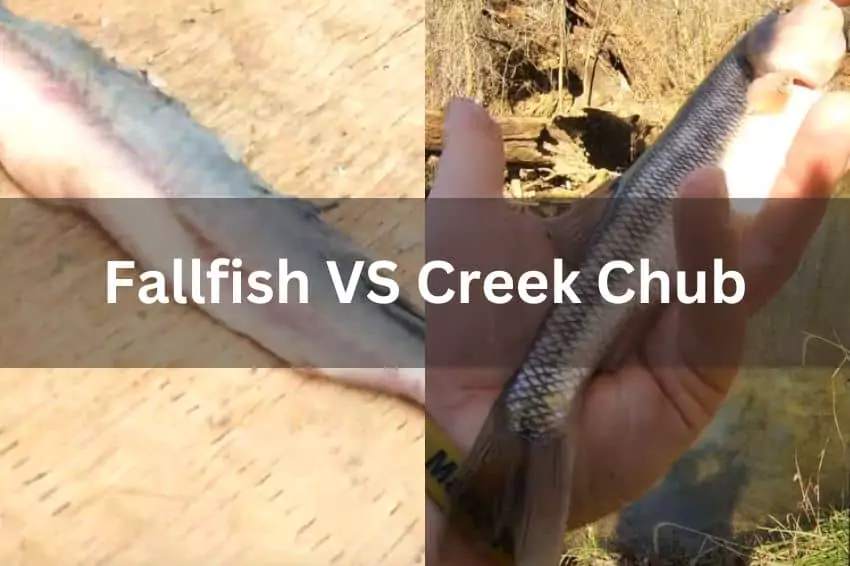Fallfish and creek chub are often overlooked as food sources. Still, they can be a sustainable and delicious option if appropriately prepared.
Traditionally, they were eaten by Native American tribes and early settlers.
I’ve prepared and eaten both species and found them to have unique and tasty flavors. Proper preparation can transform these “trash fish” into a nutritious and flavorful meal.
Overview of the article
- Fallfish and creek chub are overlooked but offer a versatile and sustainable option.
- They can be prepared in various ways, such as smoking, frying, baking, and grilling.
- Fallfish are longer and more slender, with a firm, meaty texture and nutty flavor. Creek chubs have a milder, delicate flavor with a less meaty texture.
- Both fish are low in calories and fat and high in protein and omega-3 fatty acids.
- Following local regulations and guidelines when fishing for these species is essential.
Creek Chub vs. Fallfish Physical Characteristics
Regarding their physical appearance, fallfish and creek chub have some distinct differences. Fallfish are typically longer and more slender than creek chub, with a silver or bronze-colored body that may be mottled with dark spots.
They also have a forked tail and a slightly upturned mouth. Creek chubs, on the other hand, have a more rounded body shape, with a dark brown or olive-colored body that may have lighter markings. They have rounded tails and relatively large mouths.
Regarding edibility, creek chub, and fallfish can be eaten, but some anglers prefer one. Fallfish are generally considered more palatable, with a firmer and meatier texture similar to salmon.
They have a slightly sweet and nutty flavor that pairs well with herbs and spices. On the other hand, Creek chub has a milder and more delicate flavor that strong seasonings can overpower. They have a softer and less meaty texture than fallfish.
To summarize the differences between fallfish and creek chub:
| Aspect | Fallfish | Creek Chub |
|---|---|---|
| Body shape | Longer and more slender | More rounded |
| Color | Silver or bronze with dark spots | Dark brown or olive with lighter markings |
| Tail | Forked | Rounded |
| Mouth | Slightly upturned | Relatively large |
| Texture | Firm and meaty | Soft and less meaty |
| Flavor | Slightly sweet and nutty | Mild and delicate |
While both fish species can be used in similar culinary applications, such as smoking or frying, understanding their physical characteristics and differences can help anglers and chefs determine which species best suits a particular recipe or dish.
Creek Chub vs Fallfish Uses

Fallfish and creek chub can be prepared in a variety of ways. Some standard cooking techniques include smoking, frying, baking, and grilling. Both species can also be used in stews, chowders, and soups.
Fallfish are often compared to salmon in flavor and texture, so many of the same cooking techniques and flavor profiles can be used. Smoking is a popular way to prepare fallfish, enhancing their sweetness and nuttiness. They can also be fried, grilled, or baked with herbs and spices.
Here, we cover the full article on how to fillet a fallfish.
On the other hand, Creek chub has a milder and more delicate flavor that strong seasonings can overpower. They are often best prepared as pan-fried with butter and lemon or baked with herbs and a light breadcrumb topping.
They can also be used in fish cakes or added to stews and soups for added flavor.
To summarize the best ways to prepare each species:
- Fallfish: smoking, frying, grilling, baking with herbs and spices
- Creek chub: pan-frying with butter and lemon, baking with herbs and a light breadcrumb topping, using in fish cakes or stews/soups
Fallfish and Creek Chub offers a versatile and sustainable option for anglers and chefs looking to expand their culinary repertoire. Their unique flavors and textures can transform them into nutritious and flavorful meals with the proper preparation.
Sustainability and Health Considerations
Regarding health benefits, both fallfish and creek chub are low in calories and fat, making them a good source of lean protein. They are also high in omega-3 fatty acids, linked to numerous health benefits, such as improved heart and brain function.
To compare their nutritional value and environmental impact, here is a summary:
| Aspect | Fallfish | Creek Chub |
|---|---|---|
| Nutritional value | High in protein and omega-3 fatty acids | High in protein and omega-3 fatty acids |
| Environmental impact | Not overfished, native species | Not overfished, native species |
Overall, both fallfish and creek chub are sustainable and healthy options for those looking to incorporate more fish into their diet. They offer a range of culinary possibilities and can be enjoyed in various dishes.
As with any food, it’s essential to consume it in moderation and accordance with local regulations and recommendations.
Fishing Tips and Regulations
If you’re interested in fishing for fallfish or creek chub, there are a few tips to keep in mind. Both species can be caught using various techniques, such as bait, fly, or spin fishing.
They are often found in streams, rivers, and other freshwater bodies with moderate to fast-flowing water.
Following local regulations and guidelines is essential when fishing for fallfish or creek chub. These may include catch limits, size limits, and fishing methods or equipment restrictions. I
In addition, it’s crucial to practice sustainable fishing practices, such as catch-and-release or using barbless hooks to minimize harm to the fish.
People Also Ask
It’s not recommended to eat fallfish or creek chub raw because of the risk of parasites and bacterial contamination. It’s always best to cook fish thoroughly to avoid any health risks.
There are no specific health risks associated with consuming fallfish or creek chub as long as they are properly cooked. However, like any fish, they may contain pollutants such as mercury, so it’s important to follow local advisories on safe consumption.
Fallfish and creek chub can be caught using a variety of fishing techniques and equipment, such as fly fishing, spin fishing, and bait fishing. They can be caught using artificial lures or live bait such as worms or minnows. It’s important to use appropriate tackle and gear for the size of the fish and the type of water you are fishing in.
Visit foodjustify.com to discover more foods!





Leave a Reply
You must be logged in to post a comment.